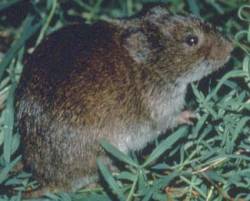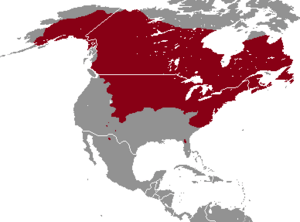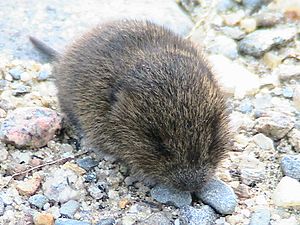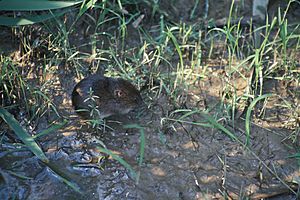Eastern meadow vole facts for kids
Quick facts for kids Eastern meadow vole |
|
|---|---|
 |
|
| Conservation status | |
| Scientific classification | |
| Genus: |
Microtus
|
| Species: |
pennsylvanicus
|
 |
|
| Range (includes western meadow vole, Florida salt marsh vole, and beach vole) | |
The eastern meadow vole (Microtus pennsylvanicus), also known as the field mouse or meadow mouse, is a small rodent. It lives in eastern Canada and the United States. You can find them from Labrador all the way down to South Carolina.
Some other voles, like the western meadow vole and Florida salt marsh vole, used to be thought of as the same species. But now, scientists know they are actually different kinds of voles.
Eastern meadow voles are busy all year, often at night. They dig tunnels underground where they keep food for winter. Female voles also have their babies in these burrows. Even though they live close together, they can be quite aggressive, especially the males during mating season. These voles can sometimes damage fruit trees and garden plants.
Contents
- Where Eastern Meadow Voles Live
- What Kind of Places They Like
- Daily Life of a Meadow Vole
- Eastern Meadow Vole Life Cycle
- Reproduction and Families
- Their Homes and Hiding Spots
- Nests and Paths
- What Eastern Meadow Voles Eat
- Who Eats Eastern Meadow Voles
- Managing Vole Populations
- Why Eastern Meadow Voles Are Important
- Threats to Meadow Voles
- Images for kids
- See also
Where Eastern Meadow Voles Live
The eastern meadow vole lives across eastern North America. Their home stretches from Labrador and New Brunswick in Canada. It goes south to South Carolina and parts of Georgia. To the west, you can find them through Tennessee to Ohio. West of Ohio, a different species, the western meadow vole, takes their place.
Some special types of eastern meadow voles live on islands. These include the beach vole and the Gull Island vole, which is now extinct.
What Kind of Places They Like
Eastern meadow voles mostly live in grassy areas. They prefer places that are a bit moist. You can also find them in some wooded areas.
In Ohio, they were found in wetlands with tall cattail plants. In Virginia, they were most common in fields with lots of thick grass. They like places with plenty of plants to hide in.
Daily Life of a Meadow Vole
Eastern meadow voles are active all year, day and night. Their activity changes based on the season and where they live. They need to eat often, usually every two to three hours. This helps them digest their food.
In Canada, they are most active:
- The first few hours after the sun comes up.
- For two to four hours before the sun sets.
They spend most of their inactive time resting in their nests.
Eastern Meadow Vole Life Cycle
Female voles are pregnant for about 20 to 23 days. When babies are born, they are pink, hairless, and have their eyes and ears closed.
- By three days old, fur starts to grow.
- By seven days, they are fully furred, except for their bellies.
- Their eyes and ears open around eight days old.
- They stop drinking milk from their mother at 12 to 14 days.
Young voles born in spring grow to adult size in about 12 weeks. Those born later in summer keep growing through the fall. Voles reach their full size between two and 10 months old.
Reproduction and Families
A typical eastern meadow vole mother has four to six babies at a time. Sometimes they can have as few as one or as many as 11 babies. On average, about 2.6 babies from each litter survive.
Litters born in fall, winter, and spring are usually smaller than summer litters. Female voles can start having babies very young, sometimes as early as three weeks old. One female in captivity had 17 litters in one year, totaling 83 babies! One of her daughters had 13 litters before she was a year old.
Most eastern meadow voles don't live very long. Their average lifespan is less than one month. This is because many young voles don't survive. Adults usually live for about two more months once they are grown. The longest a vole has lived in the wild is 16 months. Very few live longer than two years.
Vole populations change a lot. Their numbers usually reach a peak every two to five years. Then, their numbers go down in the years between. Breeding often stops in January and starts again in March. Over a year, there are usually fewer voles in early spring. Their numbers then grow quickly through summer and fall.
In a normal year, you might find 15 to 45 voles per acre in old fields. In peak years, there can be up to 150 voles per acre in marshy areas. Some places can even have over 600 voles per acre!
Their Homes and Hiding Spots
The best home for an eastern meadow vole is a moist, thick grassy area. They like places with lots of dead plant material on the ground. They choose their homes based on how much grass and other plants are there. Things like soil temperature, moisture, and even the type of soil also matter.
Eastern meadow voles are often found where the soil is wet. If they live near other types of voles, they might stick to the wettest spots.
In Massachusetts, more voles lived in grassy fields with fewer woody plants. They liked areas with more grasses and herbs. If there wasn't much grass, they would choose woody areas for cover.
Eastern meadow voles usually stay in their home areas. They will defend parts of their home from other voles. Their home areas often overlap and have irregular shapes. The size of their home depends on:
- The season (larger in summer).
- The habitat (larger in marshes than meadows).
- How many other voles are around (smaller when there are more voles).
Home ranges can be from about 0.08 to 2.3 hectares (0.32 to 0.9 acres). Females usually have smaller home ranges than males. But females are more protective of their space. Sometimes, young voles from one litter are still in the mother's home range when new babies are born.
Nests and Paths
Voles use nests for their babies, for resting, and to stay safe from bad weather. They build nests from woven grass. Nests are often underground or hidden under:
- Boards
- Rocks
- Logs
- Brush piles
- Hay bales
- Fenceposts
- Thick clumps of grass
In winter, nests are often built on the ground surface under a blanket of snow. They usually build them against a rock or log.
Eastern meadow voles also create clear paths or "runways" through dense grasses.
What Eastern Meadow Voles Eat
Eastern meadow voles eat most types of grasses, sedges, and other plants. This includes many plants grown on farms. In summer and fall, they cut grass into small pieces to get to the juicy parts of the leaves and seeds. They also eat leaves, flowers, and fruits from other plants. Sometimes, they eat fungi, insects, and snails. They might even eat dead animals. If there are a lot of voles, they might even eat other voles. They can also damage woody plants by chewing off the bark.
In winter, they eat the green parts of grass plants that are hidden under the snow. They also eat seeds, roots, and bulbs. They store seeds and tubers in their nests and burrows for later.
Some of their favorite plants include:
- Quackgrass
- Sedges
- Fescues
- Wild strawberry
- Timothy
- Bluegrasses
- Bird vetch
Who Eats Eastern Meadow Voles
Eastern meadow voles are a very important food source for many animals. Many hawks, owls, and other meat-eating mammals hunt them. Some snakes also eat them. Almost all birds of prey eat voles. Even some birds not usually thought of as hunters, like gulls and crows, will eat voles.
Some of their main predators include:
- American short-tailed shrew (voles try to avoid areas where these shrews are common)
- Badger
- Striped skunk
- Weasels
- Marten
- Domestic dog
- Domestic cat
- Mountain lion
Even some fish, like trout, and snakes, like garter snakes, have been known to eat voles.
Managing Vole Populations
Eastern meadow voles are common in farm areas. They can damage many crops, including:
- Root vegetables (like asparagus)
- Leafy vegetables (like broccoli)
- Low-growing fruits (like beans)
- The bark of fruit trees
- Pastures and hay fields
- Grains
They are also considered pests in tree plantations. They can eat young tree seedlings, especially under thick plant cover.
To manage vole populations in farm areas, people try to reduce their habitat. This can be done by mowing or plowing grassy areas along roadsides and fencerows. Protecting animals that eat voles, especially birds of prey, helps keep vole numbers in check.
Other ways to control voles include:
- Trapping (not very effective for large numbers)
- Fencing (limited effectiveness)
- Poisoning (can be effective)
- Repellents (usually don't work well)
Plastic mesh cylinders can protect young trees from vole damage. Cultivating fields at the right time and controlled fires can also help reduce vole populations.
Voles can carry tiny parasites, like worms, lice, fleas, and ticks. They can also carry diseases that can affect humans, such as:
- Tularemia
- Bubonic plague
- Lyme disease
Why Eastern Meadow Voles Are Important
Like many small mammals, eastern meadow voles play a big role in nature. They are a key food source for many predators. They also help spread tiny fungi that are good for plants. Voles eat a lot of grass and help spread nutrients through their droppings.
After big events like forest fires, voles help the habitat recover. They like open, non-forest areas. They quickly move into new open spaces created by fires or other clearings. You won't find many voles in thick forests. In these new open areas, voles quickly become food for other animals.
Threats to Meadow Voles
The eastern meadow vole is common across eastern North America. However, some groups of voles living on islands are at risk. They face dangers from invasive species, which are plants or animals that don't naturally belong there. The Gull Island vole went extinct because of this.
Also, voles need moist places to live. In the southeastern United States, some areas might become drier due to climate change. This could put vole populations there at risk.
Images for kids
See also
 In Spanish: Microtus pennsylvanicus para niños
In Spanish: Microtus pennsylvanicus para niños








